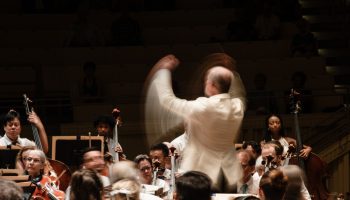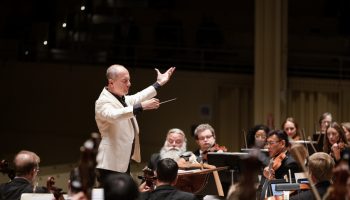Gabriel Weber
Staff writer

The Chautauqua Symphony Orchestra is preparing a program woven together by grief and soul in a way that emphasizes the importance of the freedom of the human spirit.
At 8:15 p.m. tonight in the Amphitheater, the CSO, conducted by School of Music Artistic Director Timothy Muffitt, will play Gabriel Fauré’s Pelléas et Mélisande Suite, Op. 80 and Sergei Prokofiev’s Symphony No. 5 in B-Flat Major, Op. 100, in a concert titled “Legend and Triumph.”
The relationship between the two pieces is that they were conceived in an era of unprecedented and unduplicated musical creativity, Muffitt said. With the Fauré work composed in 1898 and the Prokofiev piece in 1944, they represent two ends of the spectrum, from more traditional to modern within that time frame.
“In the world of classical music, 50 years is a very short amount of time when we’re talking about music in general, which has been around since time immemorial,” Muffitt said. “The Fifth Symphony by Prokofiev is very much an echo of the 20th century and is in that style called 20th-century Romanticism. The Fauré is a little more of a splinter, in that he came out of this tradition of French music from Debussy and Ravel.”
Pelléas et Mélisande details the attraction and ultimate tragedy between a woman and her husband’s brother, ending in her untimely death. This is a recognizable piece, Muffitt said, that will be absolutely perfect for a contemplative, outdoor summer concert.
“This work is a dreamscape. There’s a certain haze around all of it — it’s dream-like,” Muffitt said. “We recognize concrete things, but you can’t look directly at them. You can only see them out of the corner of your eye, but the result is just ravishingly beautiful music.”
Symphony No. 5 is a neo-Romantic work, written in only one month and representing the culmination of an entire period in Prokofiev’s work. It is a symphony on the greatness of the human soul, finished just months before the end of World War II.
“For the listener to know that one element, the whole piece lines up in ways that words can’t explain. If we know that when we go in to hear this work, it speaks to us in a very direct way,” Muffitt said. “Prokofiev was looking to create something uplifting amidst all the tragedy. The one thing that — in a time of war when there’s so much conflict — we have in common is that we’re all humans. I think maybe he was looking for some common ground that we could all share.”
Muffitt and Principal Flutist Richard Sherman have known each other for decades, as they met at Chautauqua and continued their professional relationship at the Lansing Symphony Orchestra where Sherman is principal flute and Muffitt is music director and conductor. Their kids went to high school together, so they have a solid foundation of mutual understanding, as well.
“I know him, both professionally and personally, very well, and vice versa. What’s great about Tim is that he has the ability to allow his solo players to express themselves, and he’ll make it very clear when he needs you to really be right with him,” Sherman said. “There’s a lot of trust that builds up between your conductor and a musician when there’s that rapport.”
They both have played these pieces together before, which works well for Sherman as there is a famous flute solo in the well-known third movement of the Fauré work, “Sicilienne,” and the CSO schedule leaves little room for learning new works. The solo is essentially one long tune that requires lyricism in the phrasing of the part.
“The Fauré is a very intimate movement. The texture is very transparent, so the flute doesn’t have to push to be heard because, you know, a flute is not a trumpet,” Sherman said. “There’s only so much volume you get from the flute before you get diminishing returns for trying to play loud. You just think about being as vocal and singing of a quality as you can without forcing.”
Prokofiev’s Fifth Symphony also has a number of flute solos, but they’re not solely alone like Pelléas et Mélisande.
“The Prokofiev work runs a myriad of emotions. It’s very heroic in places and rhythmically compelling. It’s also very lyrical. In some ways, the piece just runs the gamut emotionally,” Sherman said. “The Prokofiev is just one of the greatest symphonies of the 20th century — it’s got everything. It features every member of the orchestra in some capacity, has great melodies and rhythm. It’s a brilliant show piece for the orchestra.”
Having played flute for over 50 years now, Sherman is intentional about staying active in order to maintain his lung capacity by trekking the Chautauqua grounds and going to the gym. His goal is to stay well enough to play as long as possible.
“Practice keeps you familiar with the eccentricities of your instrument’s tendencies,” Sherman said, “and I think learning to not overplay when there’s so many concerts and rehearsals is keeping your body fluid.”
A professor of flute at the Michigan State University College of Music, Sherman finds that teaching keeps his mind fluid too, through reinforcing his concepts and philosophy of music-making. When he recently asked a former student what they came away with after studying with him, they answered that Sherman led by setting a good example.
“I feel a responsibility to be ready to demonstrate for students the nonverbal communication part, and that was very gratifying for me to hear because it’s a big incentive to continue to keep my standards and my level of playing up,” Sherman said. “The artist-teacher model is a very difficult balance to strike, and many people don’t do it. They either do one or the other because it is very demanding, but I try to find the best of both in my career.”
Though Sherman has built a life around playing the flute, he finds that the joy is less about the instrument and more about the art.
“I’ve always considered myself a musician who plays the flute — that’s my medium. I am also a pianist, but I don’t think that comes quite as naturally to me,” Sherman said. “I became more of a flute nerd later in my life, but I always thought the best music was in the orchestra. And I just feel very, very grateful to have this job in the summer because it offsets and highlights what I do during the year.”




